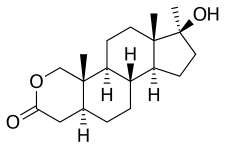 | |
 | |
| Clinical data | |
|---|---|
| Trade names | Oxandrin, Anavar, others[1] |
| Other names | Var; CB-8075; NSC-67068; SC-11585; Protivar; 17α-Methyl-2-oxa-4,5α-dihydrotestosterone; 17α-Methyl-2-oxa-DHT; 17α-Methyl-2-oxa-5α-androstan-17β-ol-3-one |
| AHFS/Drugs.com | Monograph |
| MedlinePlus | a604024 |
| Pregnancy category |
|
| Routes of administration | By mouth |
| Drug class | Androgen; Anabolic steroid |
| ATC code | |
| Legal status | |
| Legal status |
|
| Pharmacokinetic data | |
| Bioavailability | 97%[4] |
| Protein binding | 94–97%[4] |
| Metabolism | Kidneys (primarily), liver[6][4] |
| Elimination half-life | Adults: 9.4–10.4 hours[4][5] Elderly: 13.3 hours[5] |
| Excretion | Urine: 28% (unchanged)[5] Feces: 3%[5] |
| Identifiers | |
| |
| CAS Number | |
| PubChem CID | |
| IUPHAR/BPS | |
| DrugBank | |
| ChemSpider | |
| UNII | |
| KEGG | |
| ChEBI | |
| ChEMBL | |
| CompTox Dashboard (EPA) | |
| ECHA InfoCard | 100.000.158 |
| Chemical and physical data | |
| Formula | C19H30O3 |
| Molar mass | 306.446 g·mol−1 |
| 3D model (JSmol) | |
| |
| |
| (verify) | |
Oxandrolone is an androgen and synthetic anabolic steroid (AAS) medication to help promote weight gain in various situations, to help offset protein catabolism caused by long-term corticosteroid therapy, to support recovery from severe burns, to treat bone pain associated with osteoporosis, to aid in the development of girls with Turner syndrome, and for other indications.[7][8][9] It is taken by mouth.[7] It was sold under the brand names Oxandrin and Anavar, among others.[1]
The drug is a synthetic androgen and anabolic steroid, hence is an agonist of the androgen receptor (AR), the biological target of androgens such as testosterone and dihydrotestosterone.[7][10] Side effects of oxandrolone include severe cases of peliosis hepatis, sometimes associated with liver failure and intra-abdominal hemorrhage; liver tumors, sometimes fatal; and blood lipid changes associated with increased risk of atherosclerosis. Additional warnings include the risks associated with cholestatic hepatitis, hypercalcemia in patients with breast cancer, and increased risk for the development of prostatic hypertrophy and prostatic carcinoma in older patients.[11] It has strong anabolic effects and weak androgenic effects, which gave it a mild side effect profile in that regard and made it especially suitable for use in women.[7] Milder side effects in women were increased sexual desire, symptoms of hyperandrogenism such as acne, and symptoms of masculinization such as increased hair growth and voice changes.[7]
Oxandrolone was first described in 1962 and introduced for medical use in 1964.[7] The drug was a controlled substance in many countries, so non-medical use for purposes such as improving physique and performance it has been generally illicit.[7][12][13][14][15] In the United States, the FDA withdrew in 2023 the approval for the drug for reasons of safety or effectiveness, following a 2019 letter from Gemini, a drug manufacturer, stating that the product was no longer being marketed.[11]
- ^ a b Mavros Y, O'Neill E, Connerty M, Bean JF, Broe K, Kiel DP, et al. (November 2015). "Oxandrolone Augmentation of Resistance Training in Older Women: A Randomized Trial". Medicine and Science in Sports and Exercise. 47 (11): 2257–2267. doi:10.1249/MSS.0000000000000690. PMID 25899102.
Oxandrolone (trade name Anavar or Oxandrin)
- ^ "FDA-sourced list of all drugs with black box warnings (Use Download Full Results and View Query links.)". nctr-crs.fda.gov. FDA. Retrieved 22 Oct 2023.
- ^ Anvisa (2023-03-31). "RDC Nº 784 - Listas de Substâncias Entorpecentes, Psicotrópicas, Precursoras e Outras sob Controle Especial" [Collegiate Board Resolution No. 784 - Lists of Narcotic, Psychotropic, Precursor, and Other Substances under Special Control] (in Brazilian Portuguese). Diário Oficial da União (published 2023-04-04). Archived from the original on 2023-08-03. Retrieved 2023-08-15.
- ^ a b c d Mozayani A, Raymon L (15 October 2003). Handbook of Drug Interactions: A Clinical and Forensic Guide. Springer Science & Business Media. pp. 513–. ISBN 978-1-59259-654-6. Archived from the original on 14 January 2023. Retrieved 6 November 2017.
- ^ a b c d Miller JT, Btaiche IF (February 2009). "Oxandrolone treatment in adults with severe thermal injury". Pharmacotherapy. 29 (2): 213–226. doi:10.1592/phco.29.2.213. hdl:2027.42/90285. PMID 19170590. S2CID 25780591.
- ^ Hemat RA (2 March 2003). Andropathy. Urotext. pp. 108–. ISBN 978-1-903737-08-8. Archived from the original on 2023-01-14. Retrieved 2017-11-06.
- ^ a b c d e f g Llewellyn W (2011). Anabolics. Molecular Nutrition Llc. pp. 342–352. ISBN 978-0-9828280-1-4. Archived from the original on 2024-04-07. Retrieved 2017-11-06.
- ^ Cite error: The named reference
LiGuo2016was invoked but never defined (see the help page). - ^ Cite error: The named reference
RojasFinnerty2012was invoked but never defined (see the help page). - ^ Kicman AT (June 2008). "Pharmacology of anabolic steroids". British Journal of Pharmacology. 154 (3): 502–521. doi:10.1038/bjp.2008.165. PMC 2439524. PMID 18500378.
- ^ a b Cite error: The named reference
fda923was invoked but never defined (see the help page). - ^ Korkia P, Stimson GV (October 1997). "Indications of prevalence, practice and effects of anabolic steroid use in Great Britain". International Journal of Sports Medicine. 18 (7): 557–562. doi:10.1055/s-2007-972681. PMID 9414081. S2CID 260169851.
Low dose 28 +/- 18; High dose 80 +/- 13
- ^ Cite error: The named reference
FDA2009was invoked but never defined (see the help page). - ^ Cite error: The named reference
CanadaLawswas invoked but never defined (see the help page). - ^ Cite error: The named reference
GovUKwas invoked but never defined (see the help page).